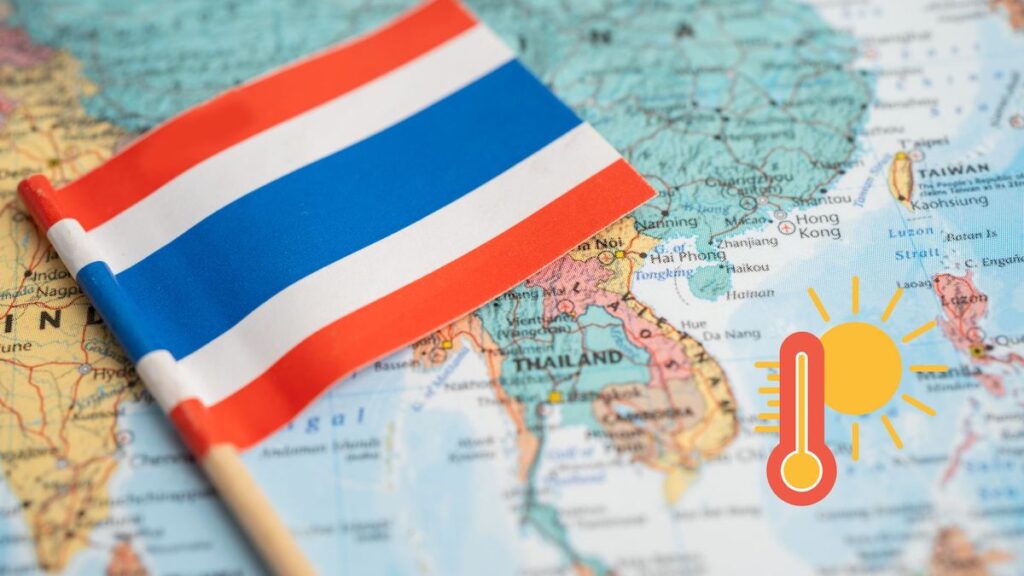Weather in Thailand
People usually say that definite seasons don’t exist in Thailand and the three seasonal periods Thailand sees are ‘hot’, ‘hotter’, and ‘hottest’. This is, of course, not entirely true as Thailand is also blessed with mild breezes during the winter and the weather can be cool enough to be pleasant. However, if you plan to visit Thailand, be prepared for searing heat most of the year round.
The weather in Thailand can be best described as tropical and humid. Some parts of the country are dominated by monsoons. The hottest months of the year fall between April and May where the average temperatures can go up to about 37-40°C, inducing numerous complaints even by the locals.
The rainy season falls between June and October when the south and the west regions are affected by monsoons. The cool season months of November, December, January, and February are probably everyone’s favorite as the temperature drops to around 18-20°C at night, which is already considered quite cold in Thailand. These months are the country’s so-called ‘winter’, bringing a number of tourists to visit Thailand.
Thailand is an elongated country stretching from the equatorial balminess of the south to the temperate coolness of the northern highlands. Here’s a quick guide by region.
Thailand Weather in Bangkok and the Center
Central Thailand has seasons that are quite defined with April being the hottest month, causing a number of Bangkokians to flee for other cooler provinces. The temperature in Bangkok and neighboring cities is mostly hot, with an average temperature being around 35-37°.
The coolest month is December when the temperature drops to about 25-30°. Monsoon downpours occasionally affect the central part of the country during the rainy season, with October sees being one of the wettest months. Some cities suffer from flooding during this period. Humidity between June and October amplifies the heat in this city, and most locals stick to air-conditioned environments.
This region includes the west part of Thailand which boasts pleasant weather almost all year round, since it comprises a mountain range that runs along the Burma border. April, just like any part of the country, can be extremely hot but the west is usually blessed by cooling breezes and sharp showers which last for only a short time, keeping the region refreshingly cool and lush. The rainy season sees short, sharp downpours which are usually followed by sunshine.
Thailand Weather in the South
A thriving oasis for lovers of the sand, sea, and a lot of sun, the southern region of Thailand sees only two seasons: the rainy and the summer. However, these two seasons visit the south at different periods on the east and the west side of the peninsular.
The southern monsoon brings rain and storms to the west coast from April through October while the east coast sees heavy rainfalls in September, October, November, and December. So, if you decide to visit the charming south, make sure you remember these periods and visit the region when it’s dry.
However, do note that the sun can be very strong in the south, luckily the sea breeze takes the edge of the heat, making it suitable year-round. You might get caught in a day-long shower in the rainy season but without the tourist crush, this time of year is better value for money.
Thailand Weather in the East
The east of Thailand includes the city of Pattaya, which experiences much the same weather as Bangkok, 150 km northwest, but benefits from sea breezes. The weather in the east is similar to that in the central part of Thailand, with more rainfalls in the rainy season due to its location on the east coast of the country. Watch out for thunderstorms during this season. The summer sees a lot of tourists in the areas, and November, December, January, and February aren’t too chilly like other regions but are affected by short sharp showers.
Thailand Weather in the North
The northern part of Thailand sees the best weather in the country, boasting defined and predictable seasons. The weather between November and May is usually dry, with November to February being a bit on the chilly side, while the temperature can be quite hot from March to May. The north of Thailand is popular among tourists; the cooling breezes make their visit to this sizzling country a little more bearable. The period you might want to stay away from is between March and June when it becomes very hazy and horribly dry. The rainy season is less torrential than in the coastal regions and November is delightfully cool yet still very lush from the rains.
Thailand Weather in Isaan
Known for its rich and unique culture, the northeast part of Thailand can be very hot and dry. The midday sun is usually very strong. It sits in a part of Thailand that doesn’t get much of the monsoon downpours and can be drought-ridden. As the region doesn’t have too many green areas, staying out in the afternoon can be too much to handle. The weather, however, gets quite chilly in the evenings. The summer period is definitely to be avoided, with boiling heat and a lot of dust. May brings rainfall to the region and makes the weather a little less unbearable. The winter is the best time to visit the region.
Weather in Thailand by Months
 December – February: December to February is the peak tourist season in Thailand, with cool and dry weather, making it a perfect time to visit most parts of the country. Northern Thailand and the mountainous regions experience cooler weather, and it can even drop below freezing at night. The average temperature in Bangkok during this period is around 26-28°C (78-82°F), while the southern regions like Phuket, Krabi, and Phi Phi Islands experience temperatures around 30°C (86°F).
December – February: December to February is the peak tourist season in Thailand, with cool and dry weather, making it a perfect time to visit most parts of the country. Northern Thailand and the mountainous regions experience cooler weather, and it can even drop below freezing at night. The average temperature in Bangkok during this period is around 26-28°C (78-82°F), while the southern regions like Phuket, Krabi, and Phi Phi Islands experience temperatures around 30°C (86°F).
March – May: Starting in March to May, the Khao San Road Bangkok season sees high temperatures and humidity levels, which can be uncomfortable for some travelers, especially in the southern parts of the country. The average temperature in Bangkok during this period is around 32-35°C (90-95°F), while the southern islands experience temperatures around 33-36°C (91-96°F). The good news is, fewer tourists visit the country during these months, resulting in lower prices and fewer crowds.
June – August: June to August is the monsoon season in Thailand, with heavy rains and high humidity. North and central Thailand experience the most rain during these months, while the southern islands experience less rain. The average temperature in Bangkok during this wet season is around 29-32°C (84-90°F), while the southern islands experience temperatures around 29-34°C (84-93°F). Although the rains can be a nuisance, these months are a great time to visit waterfalls and national parks, which are lush and vibrant.
September – November: From September to November, Thailand experiences a second bout of monsoon rains, and the northern, central, and eastern regions of Thailand experience most of the rains. However, November marks the start of the cool season in the country, with great weather, clear skies, and fewer tourists. The average temperature in Bangkok during this period is around 29-31°C (84-88°F), while the southern regions experience temperatures around 30°C (86°F).
Frequently Asked Questions about Weather in Thailand
When Is the Coldest Weather in Thailand?
Despite being known for its warm, tropical climate, Thailand does actually have a colder season, with temperatures dropping significantly from their usual highs. The coldest time of year in Thailand is typically between December and February, when visitors to the country may find themselves needing to pack a sweater or jacket. Despite the colder weather, this time of year is a popular tourist season, with beach-goers still able to enjoy the sunny days while also taking advantage of cooler evenings for outdoor activities. For those looking to escape the colder weather in their home countries, Thailand’s winter season may be the perfect solution.
Does Thailand Ever Get Cold?
When we think of Thailand, we often picture white sandy beaches, crystal clear waters, and constant tropical heat. But does this mean that Thailand never experiences cooler temperatures? While it may not be the norm, Thailand does in fact have a cooler season. During the months of November through to February, northern Thailand can experience temperatures that fall below 20°C, with the occasional dip into single digits. This cooler season is particularly welcomed by tourists who often visit for the famous festivals that occur during these months such as the Loy Krathong and Songkran festivals. So, while Thailand may be known for its heat, it’s always worth packing a light jacket or jumper for those cooler days during the winter months.
Is It Warm in Thailand?
Thailand is known for its tropical climate, which means it’s generally warm throughout the year. With average temperatures ranging from 26-32 degrees Celsius, this Southeast Asian country offers a hot and humid environment for visitors to explore. While the heat may feel intense at times, it’s also what makes Thailand’s beaches and lush forests so inviting. Don’t forget to pack your sunscreen, lightweight clothing, and a hat to protect you from the sun’s rays while you explore this unique and captivating country.
What Month Should You Avoid Thailand?
Thailand is a wonderful place to visit all year round, but there is one month in particular that you may want to avoid – September. This is traditionally the wettest month in Thailand, with a lot of rain and high humidity. Although the rain can be refreshing and pleasant, it can also put a damper on your plans if you were hoping to do some outdoor activities. This being said Thailand has so much to offer, even during the rainiest months. If you do find yourself in Thailand during September, don’t worry – you can still enjoy delicious cuisine, beautiful temples, and stunning beaches. Just make sure to pack a raincoat and some waterproof shoes!
How Warm Is the Sea in Thailand?
When it comes to the sea in Thailand, there are a few factors at play that determine just how warm the waters might be. Generally speaking, the ocean temperature in Thailand can range from about 27 to 30 degrees Celsius depending on the time of year and where exactly you are in the country. Of course, these are just averages and it’s always best to check on the weather and sea conditions before heading out for a swim. The warm waters of Thailand make it a popular destination for beach-goers and water sports enthusiasts alike. Whether you’re looking to soak up the sun or try your hand at scuba diving, the warm sea is sure to provide an enjoyable experience.
Conclusion
Thailand is a beautiful country that can be visited year-round if you know what to expect regarding its weather. The best time to visit Thailand depends on your preferences and activities. For instance, if you want to sunbathe and engage in water activities, the dry season between December to February is ideal. On the other hand, if you want to avoid crowds and enjoy lower prices, traveling during the monsoon seasons between June to August and September to November will be perfect for you. We hope this guide helps you plan your visit to Thailand better.






